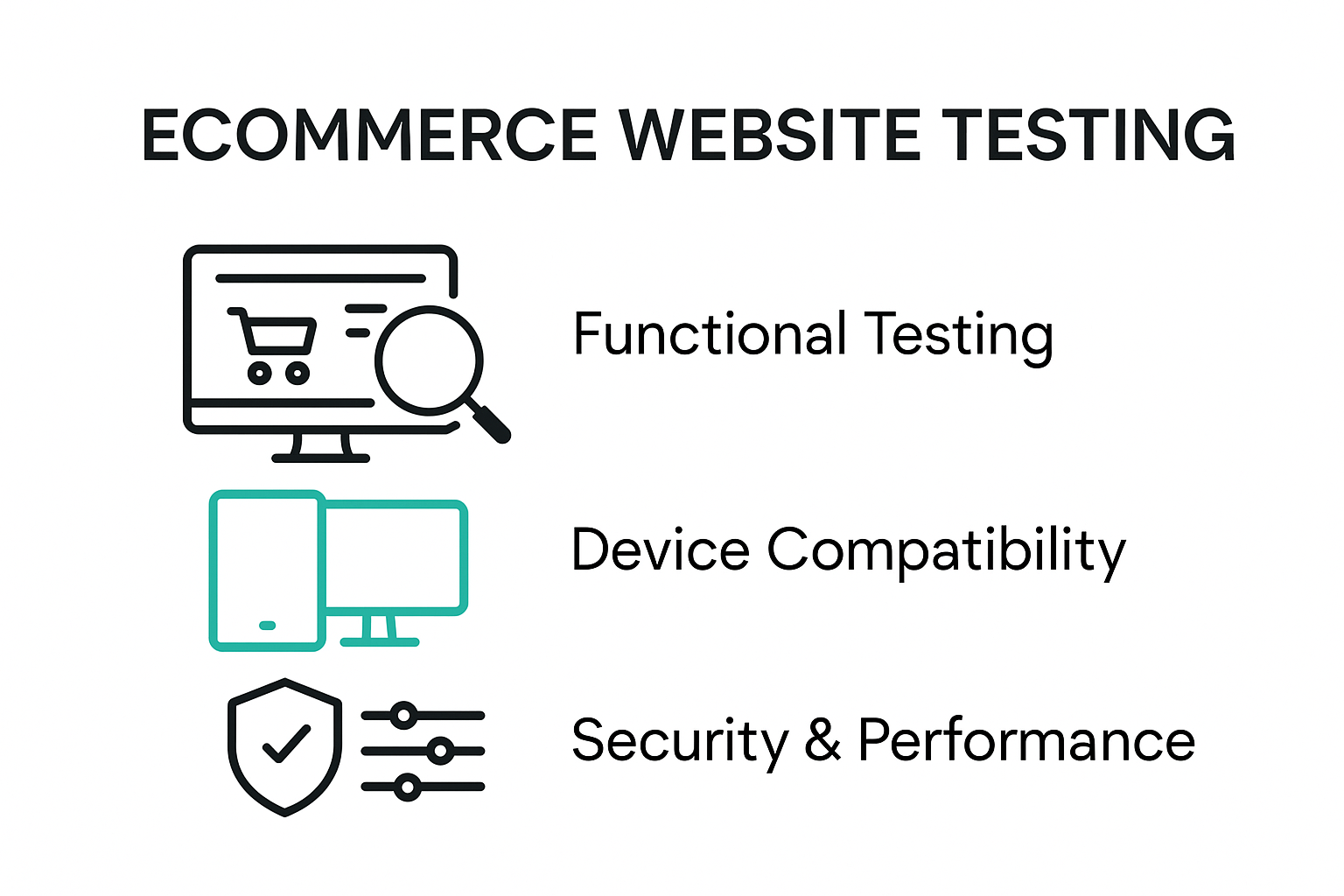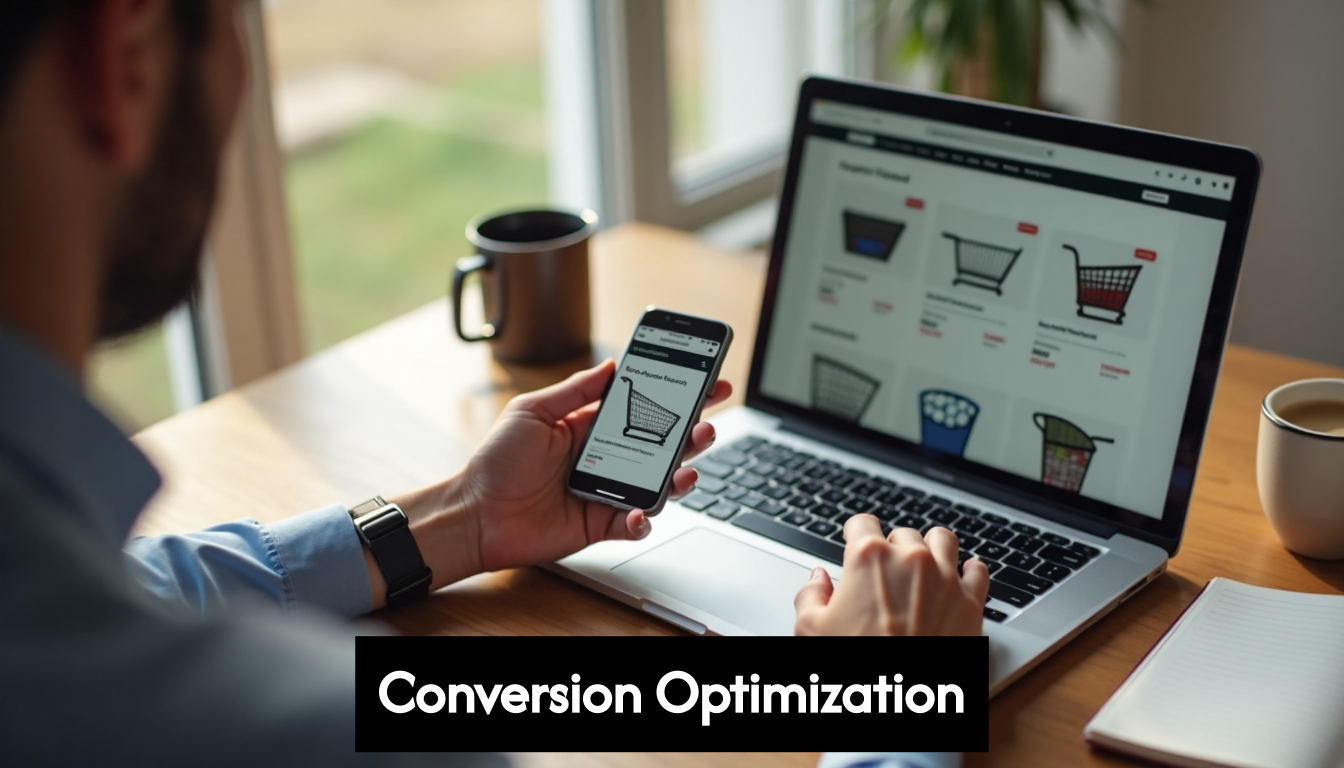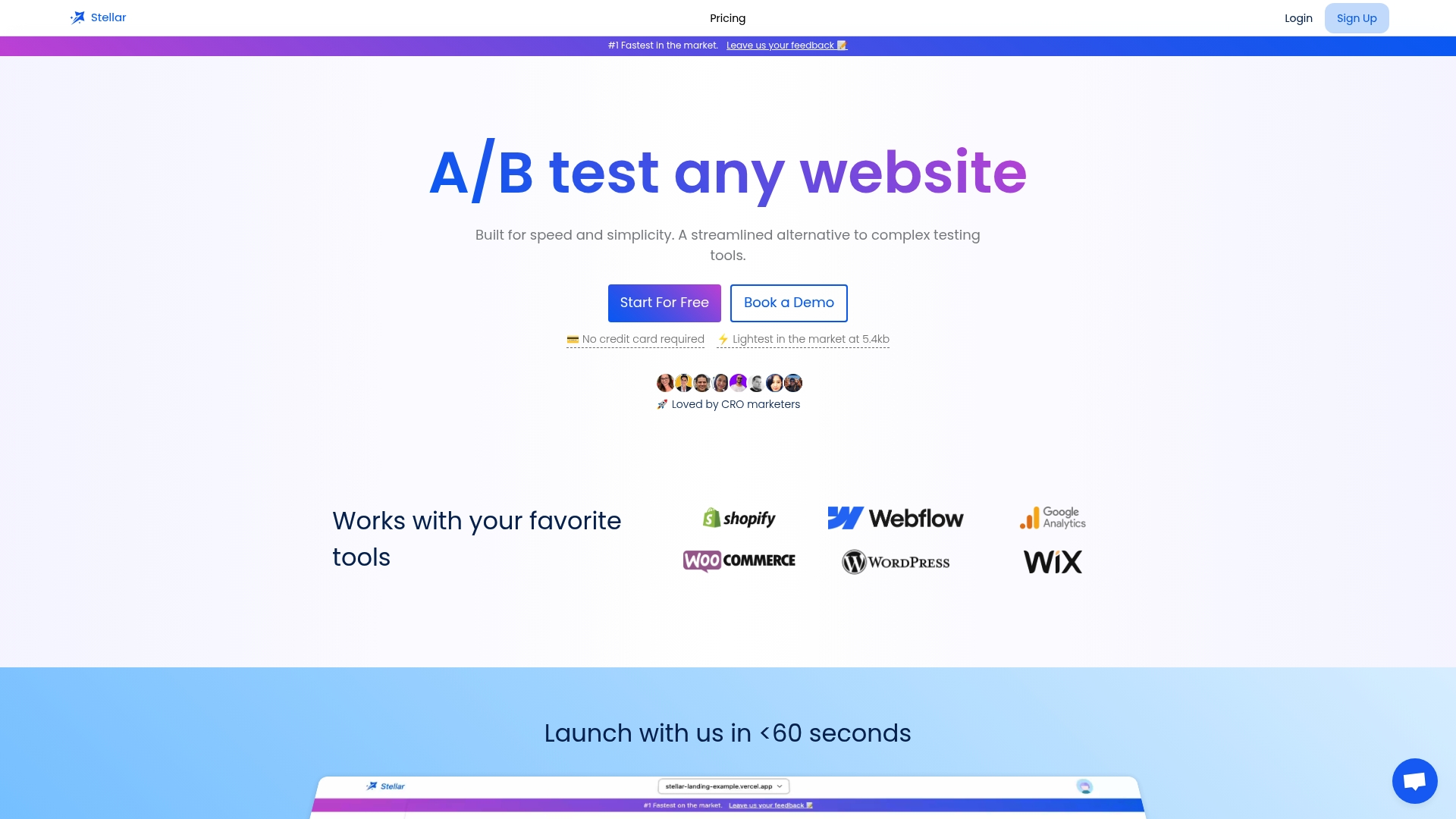
Ecommerce Website Testing: Optimize Conversions for 2025 Success

Ecommerce websites live or die by their ability to turn visitors into buyers. Websites that load in just one second convert 2.5 times more than those that take five seconds. Surprised? Most brands obsess over new features and eye-catching designs, but ignore the relentless testing needed to keep those shoppers clicking through. What actually unlocks higher sales is not what you add, but what you relentlessly test, measure and optimize—and that is where the leaders pull ahead for 2025.
Table of Contents
- Key Elements Of Ecommerce Website Testing
- Essential Test Cases For Conversion Optimization
- Best Practices For Seamless User Experience
- Top Tools And Automation Strategies For 2025
Quick Summary
| Takeaway | Explanation |
|---|---|
| Comprehensive Functional Testing is Essential | Implement thorough functional performance assessments to ensure smooth interactions, focusing on user registration, search functionality, product display, cart management, and checkout workflow. |
| A/B Testing Drives Conversion Optimization | Utilize A/B testing to refine user experience by comparing different website variations, focusing on call-to-action elements, product page layouts, and the checkout process. |
| Ensure Cross-Device Compatibility | Test for consistent performance across various devices and browsers to minimize user frustration and ensure a seamless transition between platforms. |
| Optimize Checkout Experience | Streamline the checkout process to reduce friction, incorporating guest checkout options, diverse payment methods, and clear error handling to enhance user confidence. |
| Embrace AI-Powered Automation Tools | Leverage AI-powered codeless automation platforms and continuous integration strategies to enhance testing efficiency, reduce technical barriers, and ensure robust performance monitoring. |
Key Elements of Ecommerce Website Testing
Ecommerce website testing represents a comprehensive approach to ensuring your online store delivers an exceptional user experience while maximizing conversion potential. Systematic testing goes beyond simple functionality checks to create a robust digital environment that meets user expectations and business goals.

Functional Performance Assessment
Functional testing forms the foundation of a reliable ecommerce platform. Learn more about conversion optimization techniques by understanding critical testing domains. According to BrowserStack, comprehensive functional testing must cover several essential areas:
- User Registration Process: Validate seamless account creation
- Search Functionality: Ensure accurate and responsive product searches
- Product Display: Confirm accurate pricing and detail representation
- Cart Management: Test add to cart, update quantity, and removal processes
- Checkout Workflow: Verify payment processing and order confirmation
Precise functional testing eliminates potential friction points that might deter customers from completing their purchase journey. Each interaction must be smooth and predictable.
Cross Platform and Device Compatibility
Modern consumers access ecommerce platforms through multiple devices and browsers. Testlio research highlights the critical need for comprehensive compatibility testing. This involves:
- Responsive design verification across smartphones
- Browser compatibility checks (Chrome, Firefox, Safari, Edge)
- Performance validation on different operating systems
- Touch interface responsiveness for mobile platforms
By ensuring consistent performance across platforms, businesses minimize user frustration and potential conversion barriers. A website that looks and functions perfectly on desktop must deliver an equally compelling experience on mobile devices.
Security and Performance Optimization
Ecommerce websites handle sensitive customer information and financial transactions. Testing must rigorously evaluate security protocols and performance metrics. Valido recommends focusing on:
- Payment gateway integration security
- Data encryption standards
- Load time performance under various traffic conditions
- Stress testing for high-traffic scenarios
- Protection against potential security vulnerabilities
Effective ecommerce website testing transforms your digital storefront from a potential risk into a reliable, trustworthy platform that encourages customer confidence and repeat business. By systematically addressing functional, compatibility, and security aspects, businesses create an environment primed for sustained growth and enhanced user satisfaction.
Essential Test Cases for Conversion Optimization
Converting website visitors into paying customers requires strategic and systematic testing approaches that go beyond traditional performance metrics. Conversion optimization demands a comprehensive understanding of user behavior and precise experimental methodologies to unlock significant revenue potential.

A/B Testing for User Experience Refinement
A/B testing represents the cornerstone of data-driven conversion optimization. Discover advanced split testing strategies that transform user interactions. According to CheckoutLinks, effective A/B testing involves methodically comparing different website variations to determine which elements most significantly impact user conversion rates.
Key elements to test include:
- Call-to-Action Buttons: Color, size, placement, and wording
- Product Page Layouts: Image positioning, description formatting
- Pricing Display: Presentation of prices and discount structures
- Navigation Menus: Simplicity and intuitiveness of site navigation
- Checkout Process: Number of steps and information requirements
Successful A/B testing requires statistical significance and careful measurement of specific conversion goals. By systematically testing and comparing variations, businesses can make informed decisions that directly improve user engagement.
Performance and Mobile Responsiveness Testing
Website speed and mobile compatibility are critical conversion drivers. Research from Instant.so reveals that websites loading in one second convert 2.5 times more effectively than those with five-second load times. Explore speed optimization techniques to maximize your conversion potential.
Critical performance testing areas include:
- Page Load Speed: Measuring and minimizing loading times
- Mobile Responsiveness: Ensuring consistent experience across devices
- Interactive Element Functionality: Smooth user interactions
- Cross-Browser Compatibility: Consistent performance on different platforms
- Resource Optimization: Minimizing unnecessary script and image loads
Checkout Process and Conversion Funnel Analysis
The checkout process represents the most crucial conversion point for ecommerce platforms. Bluehost research emphasizes the importance of reducing friction during the final purchase stages. Essential test cases focus on streamlining user experience and eliminating potential abandonment triggers.
Key checkout optimization strategies include:
- Guest Checkout Options: Reducing registration barriers
- Payment Method Diversity: Supporting multiple payment channels
- Error Handling: Clear, supportive messaging for form completion
- Progress Indicators: Transparent checkout stage visualization
- Security Trust Signals: Displaying security certifications
Comprehensive conversion optimization testing transforms websites from static platforms into dynamic, user-centric experiences. By continuously testing, measuring, and refining each interaction point, businesses can create compelling digital environments that naturally guide users toward purchase decisions.
Best Practices for Seamless User Experience
Creating a seamless user experience goes beyond aesthetic design and requires a strategic approach to understanding and anticipating user needs. User-centric testing forms the foundation of an intuitive and engaging ecommerce platform that naturally guides customers through their purchasing journey.
Navigation and Search Optimization
Explore personalization strategies that enhance user experience while maintaining site performance. According to Valido, efficient navigation and search functionality are critical components of a seamless user experience. Businesses must focus on creating intuitive pathways that minimize user effort and maximize engagement.
Key navigation testing considerations include:
- Menu Structure: Logical and hierarchical organization
- Search Functionality: Accurate and relevant results
- Filter Options: Precise product narrowing capabilities
- Breadcrumb Navigation: Clear site location indicators
- Mobile Menu Responsiveness: Simplified touch interactions
Effective navigation reduces user frustration and creates a smooth path from initial product discovery to final purchase. Each interaction should feel natural and require minimal cognitive effort from the user.
Cross-Device Experience Consistency
Testlio research emphasizes the critical importance of consistent user experiences across multiple devices and platforms. Modern consumers expect seamless transitions between smartphones, tablets, and desktop computers. Testing must comprehensively validate that every aspect of the ecommerce platform performs identically regardless of access point.
Critical cross-device testing elements include:
- Responsive Design: Consistent layout and functionality
- Touch Interface Adaptation: Mobile-specific interaction patterns
- Performance Consistency: Uniform loading speeds
- Content Scalability: Readable text and clear images
- Interactive Element Responsiveness: Smooth user interactions
By ensuring a uniform experience across devices, businesses eliminate potential friction points that might discourage users from completing their purchase.
Personalization and User Journey Mapping
User-centric testing requires deep understanding of individual user behaviors and preferences. Testlio experts recommend designing test scenarios that reflect actual user expectations and interaction patterns. This approach transforms testing from a technical exercise into a strategic user experience optimization process.
Personalization testing focuses on:
- Adaptive Content: Dynamic recommendations
- User Preference Tracking: Intelligent suggestion mechanisms
- Contextual User Flows: Personalized navigation paths
- Accessibility Considerations: Inclusive design elements
- Performance Personalization: Tailored loading experiences
Successful user experience testing creates an environment that feels simultaneously intuitive and individually tailored. By anticipating user needs and eliminating potential barriers, ecommerce platforms can create compelling digital experiences that naturally guide customers toward conversion.
The goal is not just to test functionality but to craft a holistic user journey that feels effortless, engaging, and uniquely personalized.
Top Tools and Automation Strategies for 2025
As ecommerce platforms become increasingly complex, automation emerges as a critical strategy for maintaining rigorous testing standards while optimizing resource allocation. Intelligent testing automation represents the future of quality assurance, enabling businesses to scale their testing capabilities with unprecedented efficiency and precision.
AI-Powered Codeless Automation Platforms
Explore advanced production testing approaches that leverage cutting-edge technologies. According to ACCELQ, AI-powered codeless automation platforms are revolutionizing ecommerce website testing in 2025. These innovative tools empower teams to create sophisticated test scenarios without extensive programming knowledge.
Key features of modern codeless automation platforms include:
- Visual Test Modeling: Drag-and-drop interface for test creation
- Self-Healing Test Scripts: Automatic adaptation to UI changes
- Cross-Platform Compatibility: Seamless testing across web and mobile
- AI-Driven Intelligent Locators: Enhanced element identification
- Integrated Reporting: Comprehensive test performance analytics
By democratizing test automation, these platforms enable teams to create more comprehensive test coverage with reduced technical barriers. The result is faster, more reliable testing processes that can keep pace with rapid digital transformation.
Continuous Integration and Strategic Test Automation
Testlio research highlights the critical importance of strategic test automation within continuous integration (CI) pipelines. Modern ecommerce testing requires a systematic approach that goes beyond simple script execution.
Critical strategies for effective test automation include:
- Business-Critical Test Case Identification: Prioritizing high-impact scenarios
- CI Pipeline Integration: Automated testing during development
- Performance and Load Testing Automation: Simulating real-world traffic
- Regression Test Suite Development: Comprehensive coverage
- Adaptive Testing Frameworks: Dynamic test strategy adjustment
Successful automation strategies focus on creating intelligent, adaptable testing ecosystems that provide real-time insights and minimize manual intervention. This approach allows businesses to maintain high-quality standards while accelerating development cycles.
Emerging Codeless Testing Tools and Platforms
BugBug analysis reveals the growing sophistication of codeless testing solutions for ecommerce platforms. These tools are designed to address the unique challenges of modern digital commerce testing environments.
Emerging tools offer advanced capabilities such as:
- Data-Driven Testing: Intelligent test scenario generation
- Cloud-Based Execution: Scalable testing infrastructure
- Cross-Browser and Device Compatibility: Comprehensive coverage
- Machine Learning Integration: Predictive test optimization
- Real-Time Performance Monitoring: Immediate insights
The future of ecommerce website testing lies in creating intelligent, adaptive testing strategies that can quickly respond to changing user expectations and technological landscapes. By embracing these advanced automation tools, businesses can transform testing from a necessary cost center into a strategic competitive advantage.
As we move into 2025, the most successful ecommerce platforms will be those that view testing not as a technical requirement, but as a critical component of delivering exceptional user experiences.
Frequently Asked Questions
What is ecommerce website testing?
Ecommerce website testing is the systematic evaluation of your online store to ensure it delivers a seamless user experience while maximizing conversion rates. This includes testing functionality, performance, security, and compatibility across different devices and platforms.
Why is A/B testing important for ecommerce?
A/B testing allows ecommerce businesses to compare different versions of web pages or features to determine which performs better in converting visitors into customers. This data-driven approach helps refine user experience by optimizing elements like call-to-action buttons and page layouts.
How can I improve my website's loading speed for better conversions?
To improve loading speed, focus on optimizing images, minimizing server response times, leveraging browser caching, and reducing the number of redirects. Research indicates that faster-loading websites convert significantly better than slower ones.
What tools can help automate ecommerce website testing?
AI-powered codeless automation platforms, continuous integration (CI) tools, and emerging codeless testing solutions are highly effective for automating ecommerce website testing. These tools reduce the need for extensive programming knowledge while ensuring comprehensive test coverage.
Ready to Eliminate Testing Bottlenecks and Accelerate Conversions?
When optimizing your ecommerce site, one major hurdle is balancing meticulous testing with fast customer experiences. As explained above, slow load times and clunky testing workflows can waste your team's energy and hurt conversion rates. You want to boost revenue and refine user journeys, but traditional A/B testing tools often feel heavy and complex for small and midsize businesses. Stellar makes optimization simple, fast, and performance-first so you can see real results instead of getting bogged down by tech headaches.

Experience the difference today. With Stellar's no-code visual editor and lightning-fast script, you will:
- Launch split tests in minutes with zero developers required
- Personalize pages for every visitor using dynamic keyword insertion
- Track every conversion instantly with real-time analytics
Stop missing opportunities to convert your visitors. Try Stellar’s free plan and discover why leading marketers turn to the fastest, most user-friendly A/B testing platform on the market. Grow your sales now—your next high-converting test is just a click away.
Recommended Articles
Published: 6/22/2025
